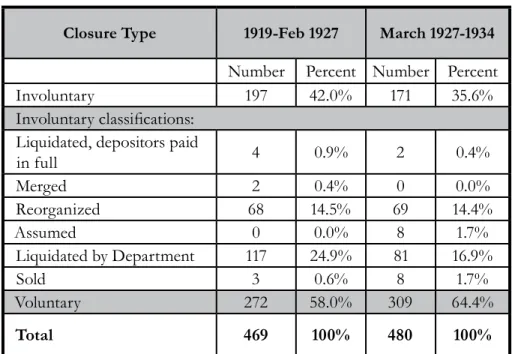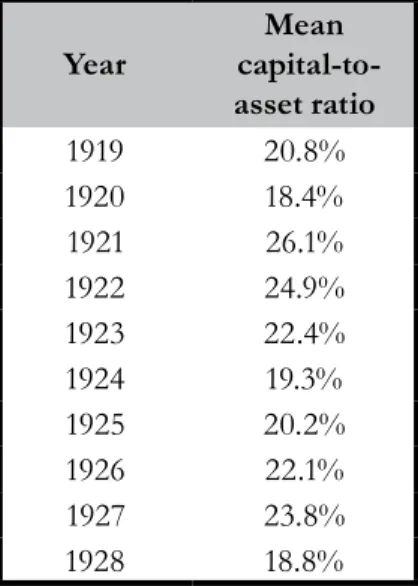Deposit insuranceanD Moral HazarD
L
indaM. H
ooks1andk
ennetHJ. R
obinson2abstract
In his comment on our 2002 Journal of Economic History paper, Gary son (2007) proposes that our work specifies moral hazard too narrowly. Richard-son posits that fixed-rate deposit insurance leads to moral hazard which takes many forms. These include not only the usual notion of risk-taking in the asset portfolio, but also mismanagement, malfeasance, and reduced incentives for depositor monitor-ing. Richardson notes that one measure of moral hazard in our empirical evidence, the loan-to-asset ratio, quantifies risk-taking in the asset portfolio only.
Richardson identifies what he considers an inconsistency in our empirical results. In a model of bank failures, the coefficient on the loan-to-asset ratio is nega-tive and statistically significant, which is not the prediction of moral hazard theory. However, the coefficient on the dummy variable for participation in the deposit-insurance program is positive. Richardson argues that this implies that risk-taking in the asset portfolio was not the only mechanism through which moral hazard worked. Instead, moral hazard also occurred through other routes, with our dum-my variable capturing the additional types of risk associated with moral hazard.
Richardson also presents evidence that these other types of moral hazard were economically significant. Using data from the Federal Reserve Board of Governors, he finds that the rate of state bank failures attributable to mismanage-ment and malfeasance was higher during some of the years that Texas had deposit insurance than during the several years after the insurance program ended.
We agree that moral hazard among our sample of Texas banks likely took many forms. For the most part, we do not have the detailed data necessary to identify other routes of moral hazard. However, Table 1 provides some additional information on bank failures from records provided by the Texas Department of 1 Department of Economics, Washington and Lee University, Lexington, VA 24450.
2 Financial Industry Studies Department, Federal Reserve Bank of Dallas.
The views expressed are those of the authors and should not necessarily be attributed to the Federal
Quantifying Moral Hazard:
A Reply to Gary Richardson
Econ Journal Watch, Volume 4, Number 3, September 2007, pp 303-307.
econ Journal WatcH 304 Banking. The Department of Banking kept a log of bank failures that noted the bank name, date of closure, and a brief explanation. It shows that 42 percent of bank failures in the six years of our study were classified as involuntary.
For comparison, in the following six years after the demise of deposit in-surance in Texas, involuntary failures fell to 35.6 percent of all failures. This evi-dence is consistent with Richardson’s claim that mismanagement occurred more frequently during the years of deposit insurance than during the years without it. The drop in involuntary failures occurred primarily in the category identified in the log as “liquidated by the Department.”
Table 1: Failures by Closure Type
Closure Type 1919-Feb 1927 March 1927-1934
Number Percent Number Percent
Involuntary 197 42.0% 171 35.6%
Involuntary classifications: Liquidated, depositors paid
in full 4 0.9% 2 0.4% Merged 2 0.4% 0 0.0% Reorganized 68 14.5% 69 14.4% Assumed 0 0.0% 8 1.7% Liquidated by Department 117 24.9% 81 16.9% Sold 3 0.6% 8 1.7% Voluntary 272 58.0% 309 64.4% Total 469 100% 480 100%
Source: Charter Registry, undated, unpublished manuscript, Texas Department of Banking, Austin, Texas.
Richardson also thinks it likely that de-capitalization was a problem for state banks during the deposit-insurance program. This view, however, is not supported by our sample. National banks, which did not participate in the de-posit insurance program, held less capital relative to assets, on average, than did state banks, as we showed in Table 1 of our paper. State banks recorded an aver-age capital-to-asset ratio of 23 percent compared to national banks’ averaver-age of 18.8 percent during the operation of the deposit insurance program. Although we did not report the fact in our original Table 1, this difference is statistically significant at the one-percent level (t = 6.75).
The sample data also show that state banks did not exhibit a steady decline in capital. Table 2 below shows that the mean capital-to-asset ratio for our sample of state banks varied without a clear pattern in the years of deposit insurance. We have sample data on these banks for only one year after the deposit insurance
program ended, but the mean for that year is not unlike that for prior years.
Table 2: Capital at State Banks
Year Mean capital-to-asset ratio 1919 20.8% 1920 18.4% 1921 26.1% 1922 24.9% 1923 22.4% 1924 19.3% 1925 20.2% 1926 22.1% 1927 23.8% 1928 18.8%
Source: Examiners Report of Condition, 1919-1928, unpublished confidential files, De-partment of Examination, archives of the Federal Reserve Bank of Dallas, Dallas, Texas.
Richardson’s insights into other forms of moral hazard at work are difficult to quantify empirically. However, examiners’ comments in the examination re-ports we used in our paper offer some support for his general claim. Each report concludes with a section titled “Management and General Condition.” In it, ex-aminers respond to the following questions: “Is the management safe?” “Com-petent?” Looking at a sample of 35 reports concerning banks that failed in the subsequent reporting period, we find that 18 of the banks were judged unsafe and incompetently managed. (Additional examiners’ comments are reproduced in Table 3 below.)
A fixed-rate deposit insurance program of the type that existed in Texas and elsewhere can encourage excessive risk taking. This moral hazard effect can take a number of different forms. Our results indicate that insured banks’ asset portfolios seemed to be affected by risk-taking incentives. Richardson posits that other forms of risk-taking activities were present. We agree with his hypothesis and offer some evidence in support of additional avenues for moral hazard to have played a role in the activities of Texas banks in the 1920s.
econ Journal WatcH 306 RefeRences
Hooks, L. M., and K. J. Robinson. 2002. Deposit Insurance and Moral Haz-ard: Evidence from Texas Banking in the 1920s. Journal of Economic History 62(3): 833-853.
The Directors admit that the affairs of the bank are in unsatisfactory condition. Director (X) is a brother-in-law of Cashier (Y). President (Z) is the father of Cashier (Y) and he readily admits that he is getting old and leaves everything up to his son.
It is plain that there is a considerable amount of ill feeling existing between Cashier and the two assistant cashiers. The assistant cashiers stated to the State Examiner and me that they believed he was not ab-solutely honest.
This is the reason why the management of this bank cannot collect loans due this bank by other bankers, their customers, their kinsmen and their interests. This bank needs a banker to manage it who has no intimate friends or relatives in this section.
While listing the ledgers, (examiner) noticed that once or twice Cashier attempted to remove a couple of ledger sheets. (Examiner) noticed that the control account had been erased, the amount being increased $22 million, and that the account with X bank showed to have been tampered with.
It seems to me this is one of, if not, the poorest managed banks it has been my duty to examine. Not only is the management incapable, but I am convinced that Active Vice President X is dishonest.
The Directors are more or less figure-heads who do not attempt to actually direct the bank’s affairs. The clerical work is not kept up in a satisfactory manner and the general appearance of the bank room is untidy.
Source: Examiners Report of Condition, 1919-1928, unpublished confidential files, Department of Examination, archives of the Federal Reserve Bank of Dallas, Dallas,
Texas.
tabLe 3: coMMentsfRoM exaMineRsat tiMeof VaRious bank faiLuRes
307 V 4, n 3, s 2007 Richardson, G. 2007. Deposit Insurance and Moral Hazard: Capital, Risk,
Mal-feasance, and Mismanagement. Econ Journal Watch 4(3). Link. abouttHeautHoRs
Linda M. Hooks is professor of economics at Washington and Lee Uni-versity. She teaches undergraduate courses in money and banking and a seminar on European monetary union, which includes travel to Europe with students. She conducts research in monetary economics and banking. Her research has been published in professional and general-interest publications, including the Journal of Economic History, Journal of Financial Services Research, Review of Financial Economics, Contemporary Economic Policy, The Group of Thirty monograph series, and Federal Reserve Bank of Dallas publications. For her sabbatical research, Dr. Hooks won an AAUW American Fellowship. Before arriving at Washington and Lee, Dr. Hooks worked as an economist at the Federal Reserve Bank of Dallas. She re-ceived her M.A. and Ph.D. in economics from UCLA, and a B.A. from Louisiana State University. Her email is hooksl@wlu.edu.
Mr. Robinson joined the Federal Reserve Bank of Dallas in August 1986 as an Economist in the Research Department specializing in macroeconomics and money and banking. He joined the Financial Industry Studies Department in February 1989 and was promoted to Senior Economist in March 1990, and to Senior Economist and Policy Advisor in March of 1993. Mr. Robinson holds a Ph.D. degree from The Ohio State University. His current research interests lie in the interaction between financial structure, monetary policy, and economic activ-ity, and the functioning of financial markets in the U.S. economy. He is a member of the American Economic Association and has published articles in several aca-demic and trade journals, as well as articles in the Federal Reserve Bank of Dallas’ publications. His email is Kenneth.J.Robinson@dal.frb.org.

